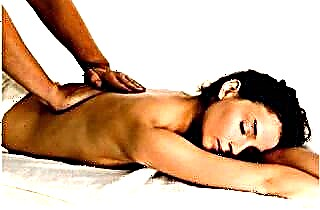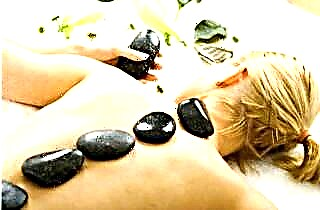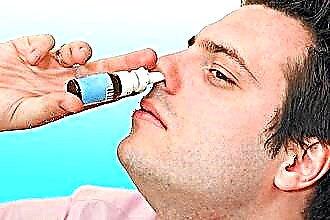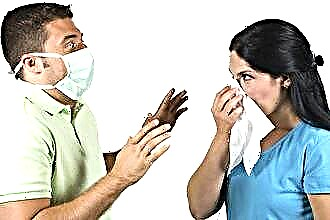Warming up is a very useful procedure for coughing, which significantly speeds up the healing process. But it only helps if you do it right. In addition, not every patient's illness can be warmed up. So it is better to get acquainted with the technique of performing such procedures better, as well as to know in advance about their features and possible contraindications.
Why is it needed
 How does regular heating help to cope with the disease? The answer is very simple - it launches various physiological processes that are beneficial for humans, which significantly accelerate recovery.
How does regular heating help to cope with the disease? The answer is very simple - it launches various physiological processes that are beneficial for humans, which significantly accelerate recovery.
When warming up the chest:
- blood circulation is activated;
- the flow of oxygen increases;
- the bronchi expand;
- breathing easier;
- intracellular processes are accelerated;
- the immune system is stimulated.
The effectiveness of the procedure largely depends on the diagnosis and the chosen method of warming up. Some of them have long-term effects on the body, others are shorter but intense. You can perform the procedure at home or in the clinic, if you can visit it regularly.
Best of all, warming up helps with colds, acute respiratory infections, acute respiratory viral infections, acute and chronic bronchitis, pneumonia, tracheitis, pharyngitis. However, before starting treatment, you must make sure that there are no contraindications, which will be discussed below.
Home warming up
At the initial stage of the disease or a not too strong cough, simple procedures that are easy to perform at home help perfectly.
 Trituration. For it, special ointments are usually used with essential oils and other ingredients that have a local irritant effect on the skin. You can buy them at the pharmacy or make your own. Proven folk remedies for rubbing when coughing are: camphor oil, alcoholic herbal tinctures, fatty base (badger, goose, goat, bear fat) with essential oils, turpentine, oil with red pepper or onion juice. It is better to rub it at night, so that later you do not get up and go outside. Usually 2-3 procedures are enough to relieve even a very severe cough.
Trituration. For it, special ointments are usually used with essential oils and other ingredients that have a local irritant effect on the skin. You can buy them at the pharmacy or make your own. Proven folk remedies for rubbing when coughing are: camphor oil, alcoholic herbal tinctures, fatty base (badger, goose, goat, bear fat) with essential oils, turpentine, oil with red pepper or onion juice. It is better to rub it at night, so that later you do not get up and go outside. Usually 2-3 procedures are enough to relieve even a very severe cough.- Compress. Warms stronger and deeper than rubbing. Therefore, you can leave it for a maximum of 2-3 hours. A vodka or honey compress gives a good warming effect. A substitute for traditional mustard plasters can be a mixture of grated raw potatoes with ground hot peppers, which also has excellent anti-inflammatory properties. It warms up no worse, but the honey-mustard cake on apple cider vinegar does not bake so much, which must be kneaded immediately before the procedure. The compress is necessarily well insulated: first, it is covered with cellophane, and then with a thick layer of cotton wool. It is very important to ensure that it fits snugly to the body, otherwise the expected result will not be achieved. You can repeat the procedure every other day.
- Iodine grid. A very simple, but quite effective method, which is especially good for chronic diseases. In addition to the fact that the treated area is deeply warmed up, the body also receives an additional amount of iodine, which, in turn, stimulates metabolic processes, accelerating them. Thus, the work of the whole organism is activated. It is very easy to make an iodine grid: with a cotton swab dipped in an alcohol solution of iodine, vertical and horizontal stripes are drawn at a distance of about 1.5-2 cm from each other. By the way, if the mesh quickly disappears, there is an obvious lack of iodine in the body and you should think about iodine-containing preparations.
 Warming up with salt. This method was also used by our grandmothers, believing that salt "draws out" illness and negative energy from the body. We will not go into discussions about the energy component of the procedure, but deep heating it makes possible due to the fact that it is able to retain heat for a long time. For the procedure, you can use ordinary rock or sea salt. It is poured into a tight linen bag and then heated in a pan, oven or microwave. It is important to ensure that the pouch does not cool down completely, because in this case, the salt will begin to "pull" heat from the body. Therefore, when the heat is no longer felt by the hand, it must be removed. You can do the procedure every day.
Warming up with salt. This method was also used by our grandmothers, believing that salt "draws out" illness and negative energy from the body. We will not go into discussions about the energy component of the procedure, but deep heating it makes possible due to the fact that it is able to retain heat for a long time. For the procedure, you can use ordinary rock or sea salt. It is poured into a tight linen bag and then heated in a pan, oven or microwave. It is important to ensure that the pouch does not cool down completely, because in this case, the salt will begin to "pull" heat from the body. Therefore, when the heat is no longer felt by the hand, it must be removed. You can do the procedure every day.- Blue lamp. Also a rather old method of warming up at home. Great for bronchitis, pharyngitis, tracheitis and even pneumonia. Blue light has a specific wavelength that can calm inflammation. The lamp works mildly, does not irritate the skin, but gives very good results. It can be used to treat children from 6 months and pregnant women.
- Paraffin therapy. One of the most powerful and effective warming procedures, which at the same time has a positive effect on the condition of the skin. It can even be used to treat small children, with strict adherence to precautions. But if paraffin is applied to infants only on the arms and legs, then, starting from a year, the child can have procedures on the chest and back, be sure to avoid the area of the heart. The procedure is best done before bedtime. To obtain a lasting result, the course of treatment is at least 5 procedures, optimally 10-15, performed every other day.
 Warming up with stones. Flat volcanic rocks are best, which fit well on the body and do not roll. But you can also use large sea or river pebbles. The stones are heated in a frying pan or oven to a temperature of 50-70 degrees (depending on the sensitivity of the skin). The patient lies on his stomach and the area of the lungs is covered with warm stones. From above, the stones are covered with a terry towel and all together - with a warm blanket. Just as when using salt, care must be taken not to let the stones begin to cool the body. This procedure greatly facilitates the discharge of phlegm and can replace drainage massage. Therefore, it is better not to leave the patient alone, especially if it is a child, and position him so that his head is slightly down. If there is a large accumulation of mucus, you can take a liquid thinner before the procedure.
Warming up with stones. Flat volcanic rocks are best, which fit well on the body and do not roll. But you can also use large sea or river pebbles. The stones are heated in a frying pan or oven to a temperature of 50-70 degrees (depending on the sensitivity of the skin). The patient lies on his stomach and the area of the lungs is covered with warm stones. From above, the stones are covered with a terry towel and all together - with a warm blanket. Just as when using salt, care must be taken not to let the stones begin to cool the body. This procedure greatly facilitates the discharge of phlegm and can replace drainage massage. Therefore, it is better not to leave the patient alone, especially if it is a child, and position him so that his head is slightly down. If there is a large accumulation of mucus, you can take a liquid thinner before the procedure.
Baths with herbal decoctions are also useful for severe coughs, and at the stage of recovery, you can go to the bathhouse. But here you have to be especially careful - these procedures have even more contraindications than the usual warming up. Therefore, it is better not to use them without consulting a doctor.
Physiotherapy procedures
Patients who are in a hospital or who have the opportunity to regularly attend a polyclinic can be prescribed warming physiotherapy procedures, such as:
 UHF;
UHF;- electrophoresis;
- Darsonval;
- solux;
- laser therapy.
They have a much more intense effect on the body, since ultrasonic and laser waves are able to penetrate deep into tissues, and electrical impulses give stronger stimulation.
The course of treatment should consist of at least 7-10 procedures, which, depending on the type of therapy, are performed every other day or daily. In no case should you supplement them with warming up at home! Therefore, if you are assigned electrical procedures, you will have to refuse all the rest.
In most cases, the contraindications for the above procedures are the same as for home procedures. But the list of them opens with pregnancy, in which no electrical effects on the body are allowed.
After warming up, in no case should you immediately go outside.The insidiousness of electric procedures is that their effect is practically not felt on the skin - it occurs at a deeper level. The more dangerous is the sharp temperature contrast after them. Therefore, if you need to go home, you will have to sit for 20-30 minutes, dress warmly and try to spend as little time as possible outdoors, especially in the cold season.
Contraindications
The very first contraindication to warming up is an increased body temperature. As a rule, this is a signal that active inflammatory processes are present in the body, which will intensify even more after the procedure. Therefore, until the temperature drops to 37.2 and holds at this level for at least a day without taking antipyretic drugs, you can forget about warming up.
Also, the procedure is not performed when:
- oncological diseases;
- enlargement or hardening of the lymph nodes;
- pulmonary or other internal bleeding;
- diseases and blood clotting disorders;
- hypertension of 2-3 degrees;
- exacerbations of chronic diseases of internal organs;
- serious cardiovascular disorders;
- chronic cough of unexplained etymology.
Without consulting a specialist, you should not do warming up when coughing for pregnant women - the body's reaction to it during this period can be unpredictable.
After the procedures, you should be especially careful to prevent hypothermia. It is necessary to keep the body warm not only until complete recovery, but also for at least two weeks afterwards, until the body's defenses are fully restored.

 Trituration. For it, special ointments are usually used with essential oils and other ingredients that have a local irritant effect on the skin. You can buy them at the pharmacy or make your own. Proven folk remedies for rubbing when coughing are: camphor oil, alcoholic herbal tinctures, fatty base (badger, goose, goat, bear fat) with essential oils, turpentine, oil with red pepper or onion juice. It is better to rub it at night, so that later you do not get up and go outside. Usually 2-3 procedures are enough to relieve even a very severe cough.
Trituration. For it, special ointments are usually used with essential oils and other ingredients that have a local irritant effect on the skin. You can buy them at the pharmacy or make your own. Proven folk remedies for rubbing when coughing are: camphor oil, alcoholic herbal tinctures, fatty base (badger, goose, goat, bear fat) with essential oils, turpentine, oil with red pepper or onion juice. It is better to rub it at night, so that later you do not get up and go outside. Usually 2-3 procedures are enough to relieve even a very severe cough. Warming up with salt. This method was also used by our grandmothers, believing that salt "draws out" illness and negative energy from the body. We will not go into discussions about the energy component of the procedure, but deep heating it makes possible due to the fact that it is able to retain heat for a long time. For the procedure, you can use ordinary rock or sea salt. It is poured into a tight linen bag and then heated in a pan, oven or microwave. It is important to ensure that the pouch does not cool down completely, because in this case, the salt will begin to "pull" heat from the body. Therefore, when the heat is no longer felt by the hand, it must be removed. You can do the procedure every day.
Warming up with salt. This method was also used by our grandmothers, believing that salt "draws out" illness and negative energy from the body. We will not go into discussions about the energy component of the procedure, but deep heating it makes possible due to the fact that it is able to retain heat for a long time. For the procedure, you can use ordinary rock or sea salt. It is poured into a tight linen bag and then heated in a pan, oven or microwave. It is important to ensure that the pouch does not cool down completely, because in this case, the salt will begin to "pull" heat from the body. Therefore, when the heat is no longer felt by the hand, it must be removed. You can do the procedure every day. Warming up with stones. Flat volcanic rocks are best, which fit well on the body and do not roll. But you can also use large sea or river pebbles. The stones are heated in a frying pan or oven to a temperature of 50-70 degrees (depending on the sensitivity of the skin). The patient lies on his stomach and the area of the lungs is covered with warm stones. From above, the stones are covered with a terry towel and all together - with a warm blanket. Just as when using salt, care must be taken not to let the stones begin to cool the body. This procedure greatly facilitates the discharge of phlegm and can replace drainage massage. Therefore, it is better not to leave the patient alone, especially if it is a child, and position him so that his head is slightly down. If there is a large accumulation of mucus, you can take a liquid thinner before the procedure.
Warming up with stones. Flat volcanic rocks are best, which fit well on the body and do not roll. But you can also use large sea or river pebbles. The stones are heated in a frying pan or oven to a temperature of 50-70 degrees (depending on the sensitivity of the skin). The patient lies on his stomach and the area of the lungs is covered with warm stones. From above, the stones are covered with a terry towel and all together - with a warm blanket. Just as when using salt, care must be taken not to let the stones begin to cool the body. This procedure greatly facilitates the discharge of phlegm and can replace drainage massage. Therefore, it is better not to leave the patient alone, especially if it is a child, and position him so that his head is slightly down. If there is a large accumulation of mucus, you can take a liquid thinner before the procedure. UHF;
UHF;

